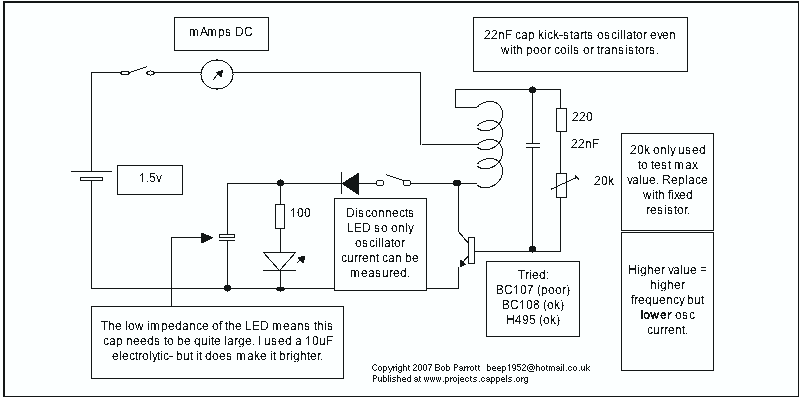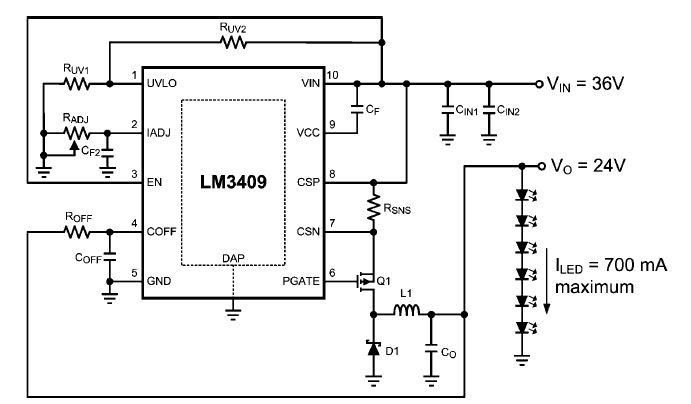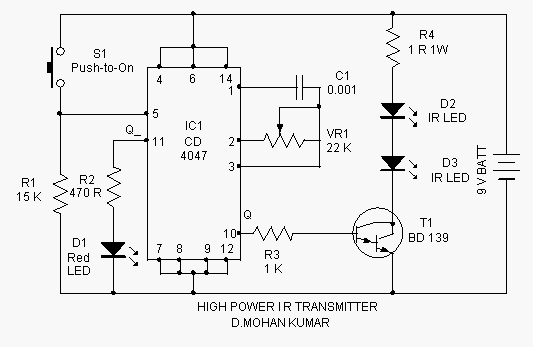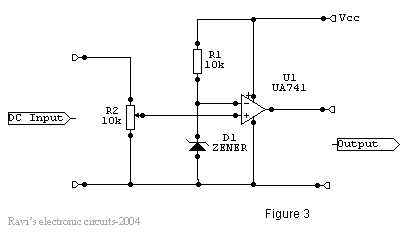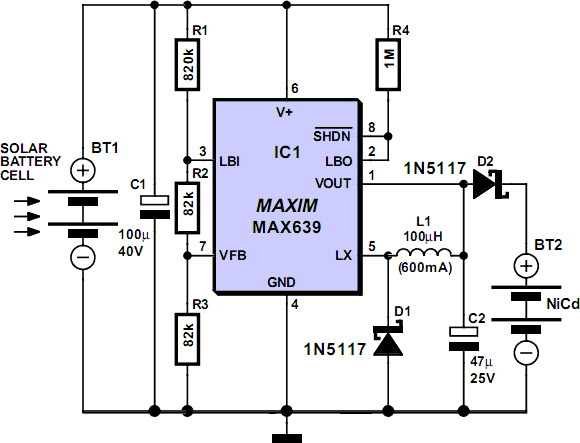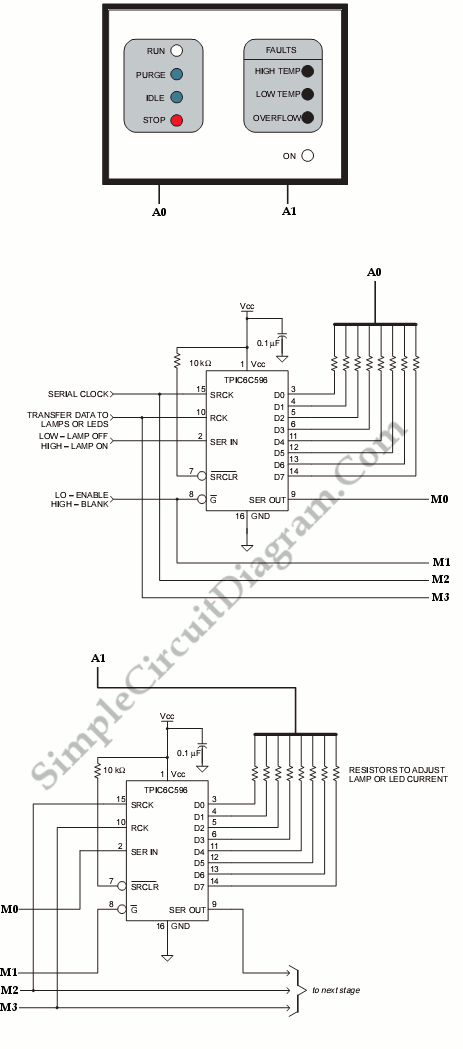
High drive oscillator-flasher
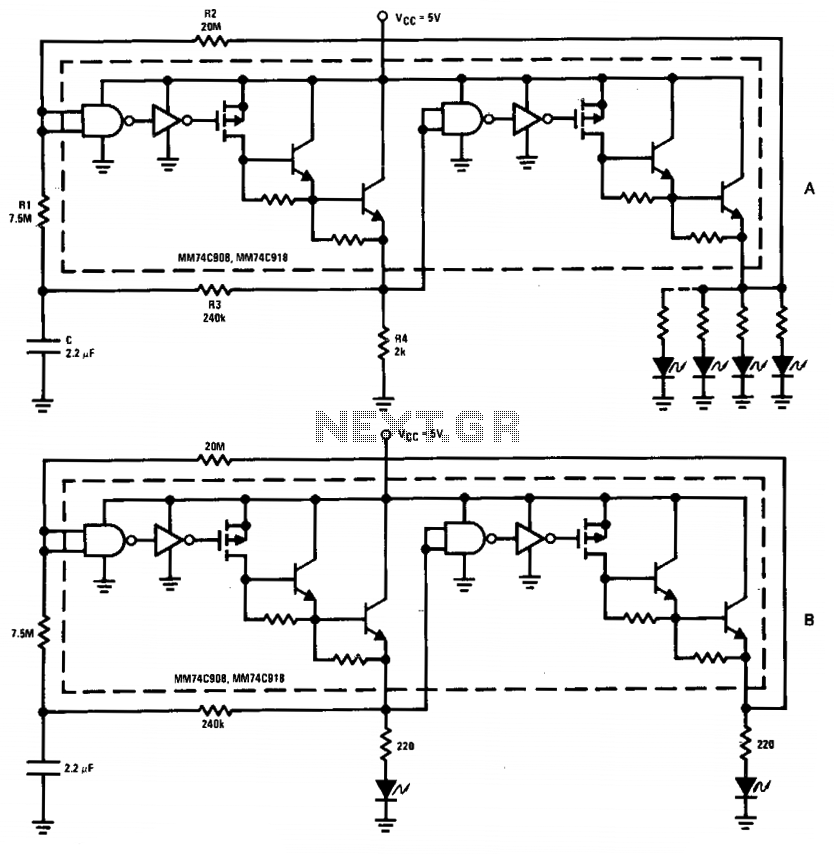
The driver in the package is configured as a Schmitt trigger oscillator (A), utilizing resistors R1 and R2 to create hysteresis. The inverting feedback timing components consist of resistor R3 and capacitor C, while resistor R4 serves as the pull-down load for the first driver. Due to its current handling capacity, this circuit is suitable for driving an array of LEDs or lamps. If resistor R4 is substituted with an LED (along with a current-limiting resistor), the circuit transforms into a double flasher, resulting in two LEDs that flash out of phase (B).
The described circuit employs a Schmitt trigger oscillator configuration, which is characterized by its ability to provide a clean, stable square wave output. The hysteresis introduced by resistors R1 and R2 ensures that the output transitions occur at distinct voltage levels, thus preventing noise from causing unintended switching. The feedback loop, formed by R3 and C, establishes the timing characteristics of the oscillator, determining the frequency of oscillation based on the RC time constant.
In this setup, R4 acts as a pull-down resistor, ensuring that the output is defined when the driver is not actively driving a load. This is particularly important in applications where the output may be left floating, as it prevents erratic behavior.
When R4 is replaced with an LED in conjunction with a current-limiting resistor, the circuit's functionality evolves. The LED will illuminate when the output is high, while the current-limiting resistor ensures that the LED operates within its safe current rating. The dual LED configuration allows for a visually engaging indicator, with the two LEDs flashing alternately due to the out-of-phase operation. This feature can be employed in various applications, such as decorative lighting, indicators, or alarms, where visual feedback is beneficial.
Overall, the circuit demonstrates versatility in its application, from basic LED driving to more complex signaling through phase-dependent flashing. The careful selection of component values will enable customization of the flashing rate and output characteristics to meet specific requirements.The driver in the package is connected as a Schmitt trigger oscillator (A) where R1 and R2 are used to generate hysteresis. R3 and C are the inverting feedback timing elements and R4 is the pull-down load for the first driver.
Because of its current capability, the circuit can be used to drive an array of LEDs or lamps. If resistor R4 is replaced by an LED (plus a current limiting resistor), the circuit becomes a double flasher with the 2 LEDs flashing out of phase (B). 🔗 External reference
The described circuit employs a Schmitt trigger oscillator configuration, which is characterized by its ability to provide a clean, stable square wave output. The hysteresis introduced by resistors R1 and R2 ensures that the output transitions occur at distinct voltage levels, thus preventing noise from causing unintended switching. The feedback loop, formed by R3 and C, establishes the timing characteristics of the oscillator, determining the frequency of oscillation based on the RC time constant.
In this setup, R4 acts as a pull-down resistor, ensuring that the output is defined when the driver is not actively driving a load. This is particularly important in applications where the output may be left floating, as it prevents erratic behavior.
When R4 is replaced with an LED in conjunction with a current-limiting resistor, the circuit's functionality evolves. The LED will illuminate when the output is high, while the current-limiting resistor ensures that the LED operates within its safe current rating. The dual LED configuration allows for a visually engaging indicator, with the two LEDs flashing alternately due to the out-of-phase operation. This feature can be employed in various applications, such as decorative lighting, indicators, or alarms, where visual feedback is beneficial.
Overall, the circuit demonstrates versatility in its application, from basic LED driving to more complex signaling through phase-dependent flashing. The careful selection of component values will enable customization of the flashing rate and output characteristics to meet specific requirements.The driver in the package is connected as a Schmitt trigger oscillator (A) where R1 and R2 are used to generate hysteresis. R3 and C are the inverting feedback timing elements and R4 is the pull-down load for the first driver.
Because of its current capability, the circuit can be used to drive an array of LEDs or lamps. If resistor R4 is replaced by an LED (plus a current limiting resistor), the circuit becomes a double flasher with the 2 LEDs flashing out of phase (B). 🔗 External reference
